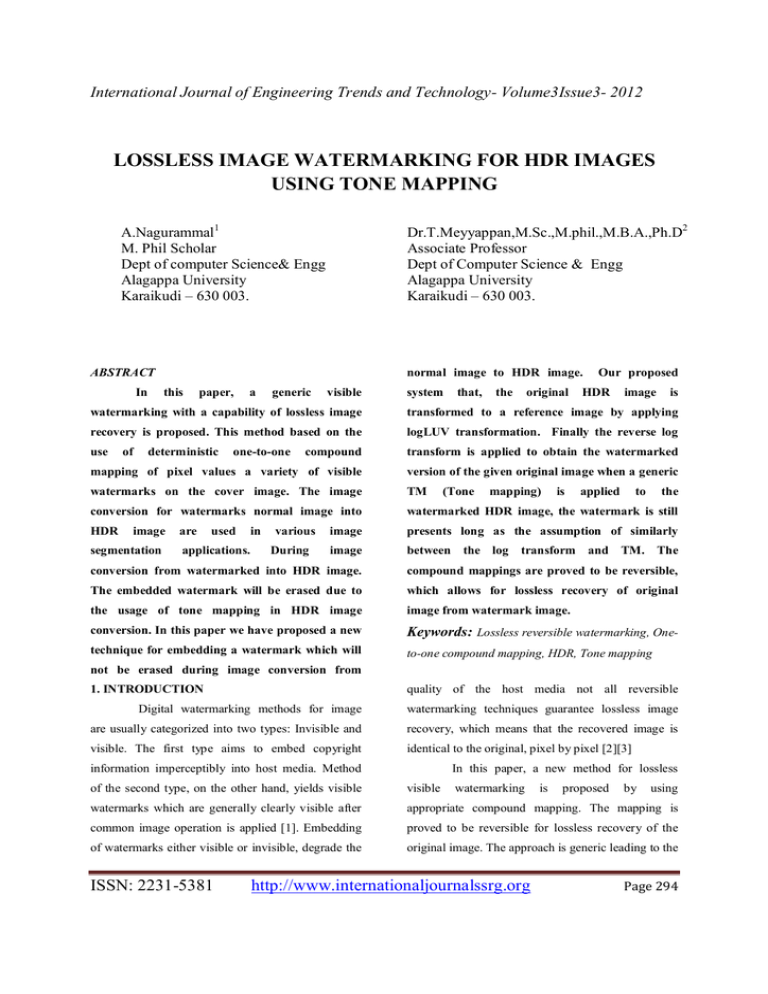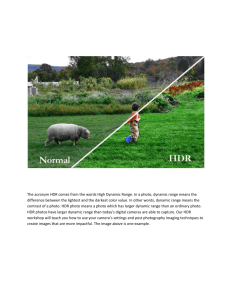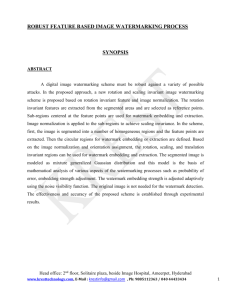LOSSLESS IMAGE WATERMARKING FOR HDR IMAGES USING TONE MAPPING
advertisement

International Journal of Engineering Trends and Technology- Volume3Issue3- 2012 LOSSLESS IMAGE WATERMARKING FOR HDR IMAGES USING TONE MAPPING A.Nagurammal1 M. Phil Scholar Dept of computer Science& Engg Alagappa University Karaikudi – 630 003. Dr.T.Meyyappan,M.Sc.,M.phil.,M.B.A.,Ph.D2 Associate Professor Dept of Computer Science & Engg Alagappa University Karaikudi – 630 003. ABSTRACT In normal image to HDR image. this paper, a generic visible system that, the original Our proposed HDR image is watermarking with a capability of lossless image transformed to a reference image by applying recovery is proposed. This method based on the logLUV transformation. Finally the reverse log use compound transform is applied to obtain the watermarked mapping of pixel values a variety of visible version of the given original image when a generic watermarks on the cover image. The image TM conversion for watermarks normal image into watermarked HDR image, the watermark is still HDR image presents long as the assumption of similarly image between the log transform and TM. The conversion from watermarked into HDR image. compound mappings are proved to be reversible, The embedded watermark will be erased due to which allows for lossless recovery of original the usage of tone mapping in HDR image image from watermark image. conversion. In this paper we have proposed a new Keywords: Lossless reversible watermarking, One- technique for embedding a watermark which will to-one compound mapping, HDR, Tone mapping of deterministic image segmentation are one-to-one used applications. in various During (Tone mapping) is applied to the not be erased during image conversion from quality of the host media not all reversible 1. INTRODUCTION Digital watermarking methods for image watermarking techniques guarantee lossless image are usually categorized into two types: Invisible and recovery, which means that the recovered image is visible. The first type aims to embed copyright identical to the original, pixel by pixel [2][3] information imperceptibly into host media. Method In this paper, a new method for lossless of the second type, on the other hand, yields visible visible watermarks which are generally clearly visible after appropriate compound mapping. The mapping is common image operation is applied [1]. Embedding proved to be reversible for lossless recovery of the of watermarks either visible or invisible, degrade the original image. The approach is generic leading to the ISSN: 2231-5381 watermarking http://www.internationaljournalssrg.org is proposed by using Page 294 International Journal of Engineering Trends and Technology- Volume3Issue3- 2012 possibility of embedding different types of visible transformed to a reference image by applying RGB- watermarks in to cover image. to-LogLUV transformation. Then the algorithm High Dynamic image embeds the watermark in LogLUV transformed represent the radiance of scenes captured by a device image. Finally the reverse LogLUV transformation is or generated by an rendering system. Due to the wide applied obtaining the watermarked version of the dynamic of visible luminance, their pixel usually take given original HDR image. When a generic TM is floating point values and thus HDR image cannot be applied to the watermarked HDR image, the directly rendered by present-day-display. In fact, the watermark is still present as long as the assumption original values must be adapted in order to fit the of similarity between the log transform and TM dynamic and color gamut of the target device. Tone operators in the luminance component holds, that is it mapping is assumed that can be obtained from through a mild image keep Range some (HDR) commercial and intellectual value because of their high quality despite nonlinear transformation against their limited dynamic range and hence they are watermarking process is robust which the possible targets for misappropriation a possible The watermark embedded in the resulting solution is represented by data hiding techniques such image of proposed system, survives any subsequent as digital watermarking, which would try to embed in TM process. The transformation RGB-to-LogLUV to any HDR image some kinds of information that since the inverse LogLUV transform is available, it should have to stay there in even after a tone allow as to obtain back the HDR watermarked image. mapping processing [4]. The original HDR Image is The most common approach is to compress 2. RELATED WORK a portion of the original host and then embed the Embedding of watermarks, either visible or compressed data together with the intended payload invisible, degrade the quality of host media in in to host [7][8][9] general. A group of techniques, named reversible In this section, we described the proposed approach watermarking [5][6] allow legitimate users to remove to lossless reversible visible. Watermarking, based on the embedded watermarks and restore the original which appropriate one-to-one compound mapping content as needed. However, not all reversible can be designed for embedding different types of watermarking technique guarantees lossless image visible watermark in to image. The original image recovery which means that the recovered image is can identical to the original pixel by pixel. watermarked image by using the corresponding be recovered lossless from a resulting reversiblemapping. 3. PROPOSED WATERMARKING 3.1 HDR Image Loading The original image converted in to HDR ALGORITHM 1 Generic Visible Watermark Embedding image from watermarking process. HDR is an image 2 Generic watermarks Removal for Lossless processing technique that attempts to make pictures Image Recovery look more natural. The HDR image will load and display in the image panel, for original image ISSN: 2231-5381 http://www.internationaljournalssrg.org Page 295 International Journal of Engineering Trends and Technology- Volume3Issue3- 2012 reference, after loading the HDR image, the image WAT has to ready for luminance conversion WAT HDR W HD Using the LOGLUV reference image to approximate Tone Mapping HDR HDR Given corresponding TM a kurtosis feature watermarked value, feature value the is expressed by T MW TM TM TM Where k is the original feature value is the A) Image without Tone Mapping quantized value, ∆ is the quantization step Q∆ (.), is B) Image with the Tone Mapping. the quantization operator, with quantization step ∆ as 3.2 LogLUV Conversion parameter, and d is the codebook shift. The shift d is The HDR image converted from RGB-to- extracted from a uniform distribution [-1/2, 1/2] in LogLUV, the original image is transformed to a and then multiplied by ∆. Previous counter-shifting reference image by applying RGB-to-LOGLUV of the original feature value is necessary to ensure transformation. The log luminance value range is that h is the nearest reconstruction point. Therefore, scaled to (0,255) as for 8 bit images. Then we get the the secret key K associates with each block a LogLUV image for watermark embedding process. codebook 3.2.1 Watermark quantization interval. The watermark embedding consists of the quantization of the feature value using one of two possible scalar quantizes, one In our case, it is a scalar quantity , whose application does not affect either imperceptibility or robustness given that it is derived exclusively from the secret key and it is independent from the host feature value. 3.2.2 Reconversion shift uniformly distributed in the In this module the water marked Luminance image is reconverted to HDR Image. Applying LogLUV-to-RGB transformation. The log-luminance values range is scaled to [0,255] as for 8-bpp LDR images. Then we get the LogLUV image for watermark embedding process. 3.2.3 Tone Mapped Image Tone mapping reduces the dynamic range, HDRW HDR or contrast ratio, of the entire image, while retaining localized contrast (between neighboring pixels), RGB->LOG TM tapping into research on how the human eye and Log->RGB visual cortex perceive a scene, trying to represent the whole dynamic range while retaining realistic color LOG W LOG W TM and contrast. Images with too much tone mapping processing ISSN: 2231-5381 have their http://www.internationaljournalssrg.org range over-compressed, Page 296 International Journal of Engineering Trends and Technology- Volume3Issue3- 2012 creating a surreal low-dynamic-range rendering of a investigated in this study, all the value pi and qi are high-dynamic-range scene. image pixel value (grayscale or color value) the 3.2.4 Reversible One-To-One Compound Mapping compound mapping f is by one-to-one function fx First, we propose a generic one-to-one with one parameter x=a or y=b, where it is the compound mapping for converting a set of numeric values for converting Algorithm1: protection Generic Visible inverse of fx function. application Watermark Embedding Output: The original image R recovered from W Steps: Input: an image A and Watermark image W a. Steps: Select the same watermarking area Q in W as that selected from the 1. Select a set of pixel from A where W is to 2. 3. 4. 5. be embedded, and cell a b. Set the value of each pixel in, watermarking area. which is outside the region Q, to be Denote, the set of pixel corresponding P equal to that of the corresponding to in by Q. pixel in W. For each pixel X with value in P, denote c. For each pixel with value in Q, the corresponding pixel in Q as Z. denote the corresponding pixel in Apply an estimation technique to derive the recovered image as X and the a to be a value close to P, using the value of the corresponding pixel Y values of the neighboring pixel of X in L as l, and conduct the following Set the value of each remaining pixel in set I, which is outside the region p to be i. Obtain the same value as equal to that of the corresponding pixel that derived by applying in A 6. original image ii. the Output: Watermarked image I same estimation technique used to recover the image iii. Set to be the value 1 3.3 Lossless Visible Watermarking Generic lossless visible watermarking iv. Restore from by setting p=Fa-1(Fb(a)) scheme in the form of a class of one-to-one compound mapping, which can be used to embed a v. Set the value X of to be P. variety of visible watermarks in to image. The embedding is reversible to recover the original image lossless Algorithm2: Lossless 4. EXPERIMENTAL RESULTS The High Dynamic Range pictures will give Image Recovery from Watermarked Image the images with higher resolution effects. In this paper, Figure -1 shows original image that is converted into the high dynamic format. After the Input: a watermarked image W and a watermark L ISSN: 2231-5381 conversion takes place the pixel values of the http://www.internationaljournalssrg.org Page 297 International Journal of Engineering Trends and Technology- Volume3Issue3- 2012 converted image is calculated. The figure- 2 is the converted image with their pixel values. Then, within (3)Original image pixel values this high dynamic range formatted image, the image that is to be watermarked is done. Now the figure -4 shows the original converted image with the embedded watermarked image. For the clear resolution effects of the watermarked image, the tone mapping technique is used to make the image to be clear. Then the original image is recovered from the watermarked image without any loss using the reversible watermarking (4)Originalimge embeded in to watermark image technique. (1) Original image (5)Tone mapping image (2)Original image converted in to HDR image (6)Original image recover from Watermarki image without any loss ISSN: 2231-5381 http://www.internationaljournalssrg.org Page 298 International Journal of Engineering Trends and Technology- Volume3Issue3- 2012 The watermarks embedded using our system 5. CONCLUSION In this paper, a new method for reversible has always been detected, with the exception of the visible watermarking with lossless image recovery cases where the given algorithms have given visually capability has been proposed. The method uses one- unsatisfactory output images. The system has also to-one compound mappings that can map image pixel been values to those of the desired visible watermarks. To watermarking algorithm operating in the same demonstrate the reversibility of the compound domain. As a final result, it could be interesting to mappings visible switch to nonblank watermarking, which will watermarking. In this paper, we presented an probably be another likely applicative scenario for algorithm detectable HDR image watermarking. This would allow us to watermarking system with the requirements of choose which blocks to use for embedding, avoiding imperceptibility and robustness. Experimental results those difficult to watermark, to this aim, an extensive have proven to be very good, especially considering study of feature variability could be of great aid in how the design parameters have been set on a single determining in which zone of the image the image and then employed for the entire test database. watermarking system is more effective. for for lossless an reversible HDR image compared to a basic spread-spectrum IEEE Int. Conf. Multimedia and Expo, Jul. 2000, vol. 2, pp. 1029– 1032. 6. REFERENCES [6] Y. Hu, S. Kwong, and J. Huang, “An algorithm for removable [1] F. A. P. Petit colas, R. J. Anderson, and M. G. Kuhn, visible watermarking,” IEEE Trans. Circuits Syst. Video Technol., “Information hiding—A survey,” Proc. IEEE, vol. 87, no. 7, pp. vol. 16, no. 1, pp. 129–133, Jan. 2006. 1062–1078, Jul. 1999. [7] Y. Hu and B. Jeon, “Reversible visible watermarking and [2]R.Mantiuk and H.P.Seidel,”Modeling a Generic Tone-Mapping lossless recovery of original images,” IEEE Trans. Circuits Syst. Operator”, Video Technol.,vol. 16, no. 11, pp. 1423–1429, Nov. 2006. 2003. in proc,ofEUCROGRAPHICS’08,2008,v01.27(2),PP.699-708. [3]G.Ward dynamic Larson,”LogLUV range images”, in encoding journal for of [8] Y. J. Cheng and W. H. Tsai, “A new method for copyright and fill-gamut,highGraphics Tools integrity protection for bitmap images by removable visible watermarks and irremovable invisible watermarks,” presented at 1998,V01.3(1),pp.15-31. the Int. Computer Symp.—Workshop on Cryptology and [4] I. J. Cox, J. Kilian, F. T. Leighton, and T. Shamoon, “Secure Information Security, Hualien, Taiwan, R.O.C., Dec. 2002. spread spectrum watermarking for multimedia,” IEEE Trans. [9] P. M. Huang and W. H. Tsai, “Copyright protection and Image Process., vol. 6, no. 12, pp. 1673–1687, Jun. 1997. authentication [5] S. P. Mohanty, K. R. Ramakrishna, and M. S. Kankanhalli, “A watermarking and invisible signal embedding techniques: A new DCT domain visible watermarking technique for images,” in Proc. approach,” presented at the Conf. Computer Vision, Graphics and of grayscale images by removable visible Image Processing, Kinmen, Taiwan, R.O.C., Aug. 2003. ISSN: 2231-5381 http://www.internationaljournalssrg.org Page 299 International Journal of Engineering Trends and Technology- Volume3Issue3- 2012 Biography: Ms.A.Nagurammal Dr.T.Meyyappan Ms.A.NAGURAMMAL is a Research scholar in the Department of Computer Science and Engineering, Alagappa University, Karaikudi, Tamilnadu, India. She has received her MCA in Computer Science from Anna University, Trichy, Tamilnadu in the year of 2011. She has presented her work in International and National level conferences. Her areas of research interests include Image Processing. Prof.T.MEYYAPPAN is working as an associate professor in the department of computer science and engg, alagappa university karaikudi, tamilnadu. He has received his Ph.D in computer science and engineering from alagappa university, karaikudi,tamilnadu. ISSN: 2231-5381 http://www.internationaljournalssrg.org Page 300





